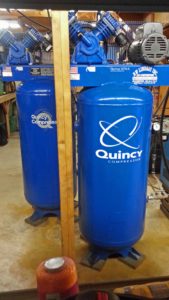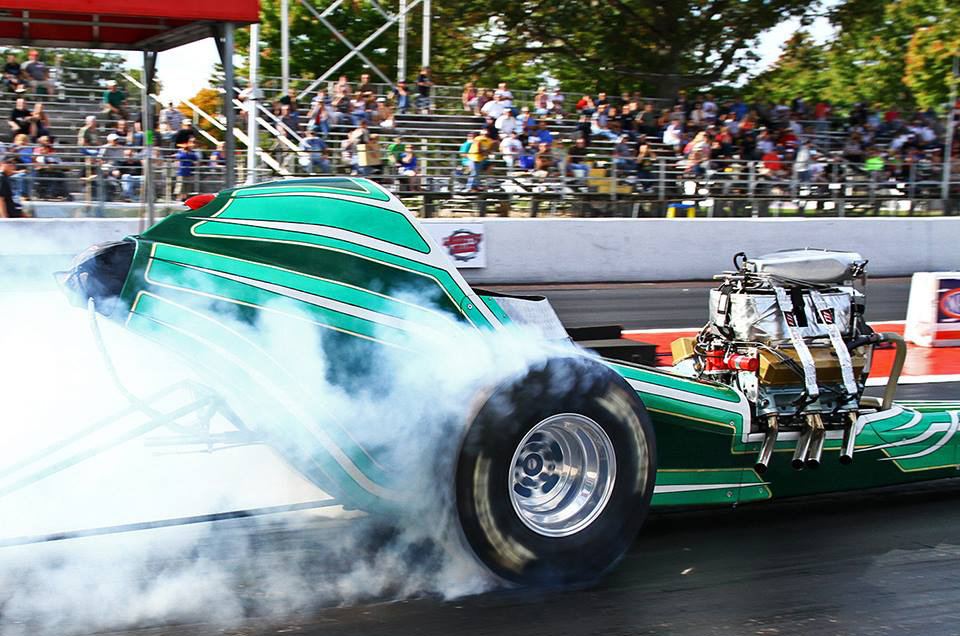Powder Coat Part 5: Air Compressors
Click image to see larger picture
We talked about the first major piece of equipment needed to prepare surfaces for powder coat. In order to run that piece of equipment you need to have another piece of equipment, an air compressor. If you have a big enough air compressor to run a sand blaster you have plenty of compressor power to run the powder coat equipment.
With an air compressor we are interested in amount of air delivered and how forcefully it can be delivered. The measurement of quantity of air delivered in the USA is CFM (Cubic Feet per Minute) and that is measured at a given PSI (Pounds Per Square Inch). Ex: 16 CFM at 90 PSI. PSI is the amount of air force delivered.
Horsepower and the design of the compressor will drive the amount of CFM and PSI a compressor can develop. You can, however, only look at CFM and PSI to simplify comparisons. The amount of Horsepower to produce a given CFM and PSI will depend on the type and efficiency of the compressor. A higher priced, high quality, compressor, may not need as much horsepower to produce the same CFM at a given PSI as a less expensive compressor.
Another defining feature is the amount of air the compressor can store. This is determined by the size of the tank attached to the compressor.
You can connect any of the three types of compressors we will talk about to any size tank. The tank size determines how much air the compressor can store. It also determines how often the compressor will have to run to maintain a working pressure. Manufacturers will tend to match the capabilities of the compressor to the tank size.
There are basically three different types of air compressors. We’ll talk about the compressors most likely found in a home shop.
>Diaphragm air compressors compress air by moving a diaphragm back and forth. They are the cheapest type of air compressor. They are typically very loud and the tank takes a long time to fill. They can be sold as oil-less or with oil (in the crankcase). They can develop rather high pressures.
>Reciprocating or piston compressors are the most common compressors available on the market. They are reasonably priced. They are a little more expensive than the diaphragm compressor and their price range depends on the quality and size of the compressor. They can be found in ranges from fractional to very high horsepower. They are easy to recognize as they have a piston structure very much like a small engine. They come in single and two stage designs.
>>The main difference between a single and a two stage compressor is the number of times that the air gets compressed before being delivered to the tank.
>>In a single stage air compressor the air is sucked into the cylinder, compressed in a single stroke of the piston and then the compressed air is sent to the storage tank. These compressors develop pressure in the 125 PSI range, but typically develop more CFM than an equally sized two stage compressor.
>>In a two stage compressor, the compressed air from the first stroke is sent to a smaller second piston for a second stroke before being sent to the storage tank. These compressors develop higher air pressure, usually in the 175 PSI range, but develop less CFM.
>Rotary screw compressors work on the principle of air filling the void between two helical mated screws and their housing. As the two helical screws are turned, the volume is reduced resulting in an increase of air pressure. These compressors are more expensive, but in recent years have become more affordable. They have many advantages: they are quiet, range in air volume size from 10 CFM to anywhere in the 4-5 figure CFM, develop a high pressure, use less power than a reciprocating compressor.
Any of these compressors will run a sand blaster. The question is how big of a blaster will you use.
 I started sand blasting control arms with a 1 HP 10 gal tank Sears Craftsman air compressor and a small Harbor Freight blasting cabinet. It used to take me an hour or more per arm. I now have two 5 HP four cylinder single stage compressors each having a sixty gallon tank. I can now do a set of four arms in about 20 minutes. Time is money so if you are trying to make a small business both the compressor and the blasting cabinet are very important.
I started sand blasting control arms with a 1 HP 10 gal tank Sears Craftsman air compressor and a small Harbor Freight blasting cabinet. It used to take me an hour or more per arm. I now have two 5 HP four cylinder single stage compressors each having a sixty gallon tank. I can now do a set of four arms in about 20 minutes. Time is money so if you are trying to make a small business both the compressor and the blasting cabinet are very important.
This is way more than what a typical person will need to start sand blasting and powder coating.
Now, very important, and often neglected is the maintenance on your compressor. Compressors need maintenance just like any other piece of equipment. There are three major things that you need to do:
>Drain the air tank daily
>Change the oil in the crankcase regularly
>Change the air intake filters regularly
Something you might consider when you know you are going to run the compressor hard (for extended periods of time) is a way to have additional compressor cooling. Take a window fan and point it at the cylinders. It will really make a difference in keeping it cool.
